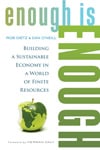I first “met” Dan O’Neill in the spring of 2009 when I was researching an article for the New York Society of Security Analysts about Herman Daly and his groundbreaking vision of the steady state economy. At the time Dan was the European director of the Center
Dan, currently a lecturer in ecological economics at the University of Leeds, and Rob Dieitz, first director of the CASSE and editor of the Daly News, have now co-authored Enough is Enough, a collection of not-so-modest proposals for achieving the steady state.
The authors maintain that the transition to a steady state economy will require a recognition of planetary limits, a set of workable public policies, and most critically, the will to act. The book is organized into three parts. The first explores the scientific evidence that points to the folly of our current pursuit of endless economic growth. Highlighted are the work of the Global Footprint Network and the reality that our energy return on energy invested (EROEI) has shrunk to a ratio of 15 to 1 in 2005 from 100 to 1 in 1930. Given that the EROEI of photovoltaic solar panels is only 7 to 1, the authors point out, we cannot expect an economy fueled by renewable energy to issue us a perpetual ticket to growth. “To bring material and energy use within ecologic limits, we must address the scale of economic activity,” the authors conclude.
That’s where the notion of the steady state economy comes in. The authors define a steady state economy as one “in which material and energy use are kept within ecological limits and where the goal of increasing GDP is replaced by the goal of improving quality of life. “ The transition to that economy will require new ways of defining investment returns, new, more democratic ownership models, and a hard look at whether we should be striving endlessly for productivity gains or instead aiming to create work that brings joy and meaning to people’s lives.
Part II of Enough is Enough gets down to the brass tacks of the possible escape routes from the perpetual growth trap: how we go about limiting material and energy throughput, stabilizing population, addressing the wealth gap, reforming our monetary and financial systems, changing the way we measure progress, and finding new ways to create business value. O’Neill and Dietz discuss a variety of policies to limit throughput, from outright limits, rationing, and tradable permit systems to indirect methods like taxation schemes and payments for ecosystem services. Their suggestions for encouraging population control through noncoercive means include the empowerment of women and public education initiatives like Global Population Speakout.
Chapter 8, “Enough Debt,” highlights the work of our own John Fullerton, and the “rolling” epiphany he began to experience in the early 1990s that led him to question the fundamental structure of our current financial system and to explore an alternative system that serves society and the biosphere.
The final and third part of Enough is Enough leads us to the inevitable realization that to achieve a global steady state developed economies need to contemplate degrowth, allowing the developing world room to grow sustainably. Indeed, the authors tell us, we all must begin in earnest to identify alternative paths to increase well-being that are less materially intensive than the ways of today’s developed world. A tall order indeed, but one, the authors maintain, we have no choice but to meet. —Susan Arterian Chang is Director of Capital Institute’s Field Guide to Investing in a Regenerative Economy initiative.

